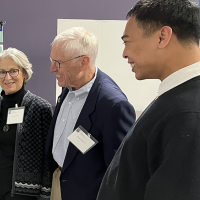When you're a kid, playing sick is something you do to get out of school. But at San Francisco State University, playing sick is something certain people do in school all the time. It's not a way to get out of classes, either. It's how the School of Nursing helps students develop the diagnosis and communication skills they'll need on the job.
All SF State nursing students interact with standardized patients -- actors who've been trained to simulate various ailments and social situations. While using standardized patients to teach students isn't rare, the complexity and realism of the School of Nursing scenarios are. Betty Grandis, a standardized patient trainer and School of Nursing lecturer who received her master of arts degree in drama from SF State in 1999, directs the scenarios using traditional theatre language and techniques.
"The stories possess an arc and adhere to a theatrical structure," Grandis said. "The characters have fully developed lives and backgrounds to bring realism and depth to the scenarios."
In one four-hour training exercise, for instance, the students begin by treating an elderly man for tuberculosis but, over the course of six simulated home visits, come to realize that his wife is showing symptoms of dementia. In another four-hour training, students interact with a teenage girl as she first seeks out contraception, then needs counseling for a sexually transmitted infection, then eventually has to deal with pregnancy and intimate partner violence.
According to Grandis, about two dozen standardized patients/actors bring the training to life each semester. Their stage: rooms in SF State's Burk Hall that have been set-dressed to look like a home and a clinic. The rooms are equipped with cameras and microphones, so while one set of students is interacting with standardized patients, others are watching from down the hall while they wait their turn.
Once a scenario concludes, students receive feedback from the actor who played the patient. He or she steps out of character to critique the students' communication skills, professionalism, empathy, and rapport building.
"In the real world, nursing students might not have a chance to actually talk to their patients about these things," Grandis said. "This gives them a chance to get valuable feedback while practicing their skills in a risk-free environment."
The School of Nursing's standardized patient training module was launched in 2010 by Director of Simulation/Lecturer Kathleen Shea, who manages the program, it doesn't just use actors to train students. Some of the program's "patients" have more in common with C-3PO than Laurence Olivier.
"Standardized patient interaction is one component in our overall simulation program," Shea said. "We complete other simulations using computerized human patient simulators as well."
Human patient simulators are mannequins that mimic a pulse, breathing, blinking, and other lifelike actions, including medical symptoms such as seizures. The School of Nursing has five such simulators, which are set up in a simulated hospital complex on Burk Hall's third floor.
"We're utilizing props, we're utilizing costumes, we're utilizing makeup," Grandis said of the simulation program. "We're doing everything that you would do in a theatrical performance to make it as real as possible for the students. And because it's real, they more fully embrace it and grow from it."




